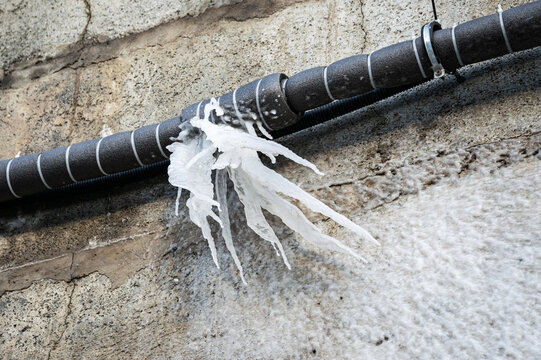Safeguarding Pipes from Cold Weather Issues: Essential Approaches
Safeguarding Pipes from Cold Weather Issues: Essential Approaches
Blog Article
We've stumbled on this post pertaining to How To Avoid Freezing Pipes below on the net and reckoned it made perfect sense to share it with you on this page.
:strip_icc()/snow-outdoor-faucet-pipes-4af65d1e5e904fb1aa7bf74071fe5d89.jpg)
Cold weather can damage your pipes, specifically by freezing pipes. Right here's exactly how to prevent it from taking place and what to do if it does.
Introduction
As temperature levels decrease, the danger of frozen pipelines boosts, potentially leading to pricey fixings and water damages. Understanding just how to avoid icy pipes is vital for house owners in chilly environments.
Recognizing Icy Pipelines
What triggers pipelines to ice up?
Pipes ice up when revealed to temperature levels listed below 32 ° F (0 ° C) for prolonged durations. As water inside the pipelines ices up, it increases, taxing the pipeline wall surfaces and potentially creating them to break.
Dangers and damages
Icy pipes can bring about water supply interruptions, property damages, and costly repair work. Burst pipelines can flooding homes and create substantial structural damage.
Indicators of Frozen Pipeline
Determining icy pipelines early can stop them from rupturing.
Exactly how to determine frozen pipes
Try to find reduced water circulation from faucets, uncommon smells or sounds from pipelines, and visible frost on revealed pipelines.
Avoidance Tips
Insulating prone pipes
Cover pipelines in insulation sleeves or utilize heat tape to safeguard them from freezing temperatures. Focus on pipes in unheated or external locations of the home.
Heating strategies
Keep indoor areas adequately heated, specifically locations with pipes. Open cupboard doors to enable warm air to circulate around pipes under sinks.
Securing Outdoor Pipes
Garden hoses and exterior faucets
Separate and drain pipes yard hose pipes prior to winter season. Set up frost-proof spigots or cover exterior faucets with protected caps.
What to Do If Your Pipelines Freeze
Immediate activities to take
If you suspect frozen pipelines, keep faucets open up to relieve stress as the ice thaws. Use a hairdryer or towels soaked in warm water to thaw pipelines slowly.
Long-Term Solutions
Architectural adjustments
Think about rerouting pipes away from outside walls or unheated locations. Add additional insulation to attics, cellars, and crawl spaces.
Updating insulation
Purchase top notch insulation for pipelines, attic rooms, and walls. Appropriate insulation helps keep consistent temperature levels and reduces the risk of frozen pipes.
Final thought
Protecting against icy pipelines calls for proactive procedures and fast reactions. By recognizing the causes, indicators, and safety nets, house owners can safeguard their plumbing throughout winter.
6 Proven Ways to Prevent Frozen Pipes and Protect Your Home
Disconnect and Drain Garden Hoses
Before winter arrives, start by disconnecting your garden hoses and draining any remaining water. Close the shut-off valves that supply outdoor hose bibs and leave the outdoor faucet open to allow any residual water to drain. For extra protection, consider using faucet covers throughout the colder months. It’s also important to drain water from any sprinkler supply lines following the manufacturer’s directions.
Insulate Exposed Pipes
Insulating your pipes is an effective way to prevent freezing. Pipe insulation is readily available at home improvement stores and is relatively inexpensive. Pay close attention to pipes in unheated areas such as the attic, basement, crawl spaces, or garage. Apply foam insulation generously to create a buffer against the cold. You can also wrap your pipes in heat tape or thermostat-controlled heat cables for added warmth.
Seal Air Leaks
Inspect your home for any cracks or openings that could let in cold air. Seal any holes around the piping in interior or exterior walls, as well as the sill plates where your home rests on its foundation. Additionally, make sure to keep your garage door closed unless you’re entering or exiting. Leaving it open creates a significant air leak that can lead to frozen pipes.
Allow Warm Air Circulation
During cold snaps, it’s essential to allow warm air to circulate evenly throughout your home. Leave interior doors ajar to promote better airflow. Open kitchen and bathroom cabinets to help distribute heat consistently around the rooms. If you have small children or pets, be sure to remove any household chemicals or potentially harmful cleaners from open cabinets for safety.
Let Faucets Drip
A small trickle of water can make a big difference in preventing ice formation inside your pipes. When temperatures drop significantly, start a drip of water from all faucets served by exposed pipes. This continuous flow helps prevent the water from freezing. Additionally, running a few faucets slightly can relieve pressure inside the pipes, reducing the chances of a rupture if the water inside does freeze.
https://choateshvac.com/6-proven-ways-to-prevent-frozen-pipes-and-protect-your-home/

I found that piece about Preventing and dealing with frozen pipes while doing research the internet. Sharing is caring. Helping people is fun. I praise you for your time. Please pay a visit to our site back soon.
Visit Homepage Report this page